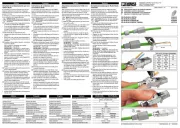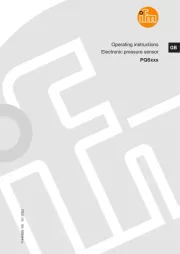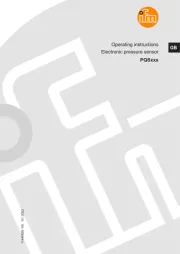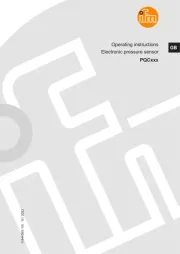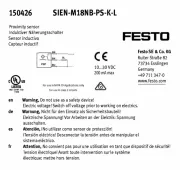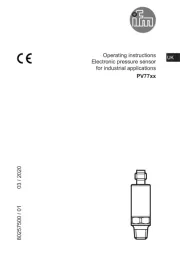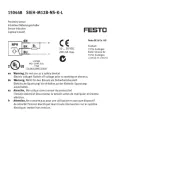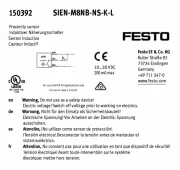Abb./Fig. 5
SUB-D-Stecker mit Schraubklemmenanschluss für PROFIBUS
SUB-D Plug With Screw Terminal Connection for PROFIBUS
Connecteur SUB-D à connexion à vis pour PROFIBUS
Conector SUB-D con conexión por tornillo para PROFIBUS
SUBCON-PLUS-PROFIB/SC2 Art.-Nr.: 27 08 23 2
SUBCON-PLUS-PROFIB/PG/SC2 Art.-Nr.: 27 08 24 5
DE
EN
FR
ES
SUBCONNEC-PLUS-PROFIB/SC2
SUBCONNEC-PLUS-PROFIB/PG/SC2
1. Description (Fig. 1)
1111 Partie supérieure du boîtier
2222 Interrupteur coulissant
33
33 Bloc de connexion
4444 Vis de fixation UNC
5555 Partie inférieure du boîtier
6666 Dispositif antitraction
77
77 Connecteur de contrôle
88
88 Vis du boîtier
Connecteur SUBCONNEC-PLUS-PROFIB/
SC2, avec ou sans connecteur de contrôle,
avec blocs de jonction à vis jusqu’à 12 Mbits/s.
Ce connecteur autorise un raccordement rapi-
de et convivial des segments de bus entrants et
sortants. Les contacts sont amenés sur des
blocs de jonction à vis disposés de façon claire
et avec un repérage en couleurs.
La résistance terminale connectable est
intégrée et déconnecte le segment sortant en
même temps qu’elle est activée (Fig.2). Cela
simplifie la mise en service du bus, qui peut se
faire par segment.
Le collier de blindage fixation
66
66, conçu pour le
câble profibus standard type A, est incorporé
dans le boîtier.
L’entrée de câble peut se faire, au choix, à droite
ou à gauche.
La version SUBCONNEC-PLUS-PROFIB/PG/
SC2 (Fig.1) comporte en plus un connecteur de
contrôle 7777 autorisant le raccordement d’un ap-
pareil de programmation ou de service, sans
interrompre le fonctionnement du bus.
2. Conseils pour le raccordement
Nous recommandons les outils à dénuder
suivants pour un dénudage rapide et conforta-
ble (Fig. 2) :
PSM-STRIP-FC/PROFIB (Réf. : 27 44 62 3)
et QUICK-WIREFOX 6 (Réf. : 12 04 38 4).
2.1. Longueurs à dénuder (Fig. 4)
Veuillez observer les longueurs à
dénuder recommandées pour un
fonctionnement sûr !
2.2. Introduction du câble
Avec le connecteur SUBCONNEC-PLUS-
PROFIB/... vous pouvez choisir d’introduire le
câble soit à droite soit à gauche.
Le connecteur est livré en standard avec entrée
de câble à gauche (Fig.5).
2.2.1. Raccordement
(pour entrée de câble à gauche)
(Fig.5)
• Vissez les conducteurs dénudés dans les
contacts correspondants du bloc de connexion.
• Le segment entrant doit toujours être raccordé
aux connexions à borne 1A/1B (y compris au
début du bus !).
• La ligne bus sortante doit toujours être con-
nectée aux connexions 2A/2B (voir Fig.2).
Veuillez prendre en compte l'impression en
couleur des blocs de jonction pour raccorde-
ment.
• Montez et vissez la partie supérieure du
boîtier. A cet endroit on monte le dispositif
antitraction pour la ligne bus.
SUBCON-PLUS-PROFIB/SC2
SUBCON-PLUS-PROFIB/PG/SC2
1. Descripción (Fig. 1)
1111 Parte superior de caja
2222 Conmutador deslizante
33
33 Bloque de conexión
4444 Tornillo de fijación UNC
5555 Parte inferior de caja
6666 Compensador de tracción
77
77 Conexión para programación
88
88 Tornillo de caja
Conector SUBCON-PLUS-PROFIB/SC2 con y
sin conexión para programación, con conexión
por tornillo hasta 12 Mbits/s.
El conector permite la rápida y cómoda conexi-
ón del cable del bus de entrada y de continua-
ción. Los contactos del conector se han condu-
cido a bornes de conexión por tornillo
señalizados en color de buena identificación.
La resistencia terminal está integrada de forma
conectable y al activar, desconecta al mismo
tiempo la línea del bus de continuación (Fig.2).
Esto permite la puesta en servicio sencilla y por
segmentos del sistema bus.
El compensador de tracción 66
66 se p1-ha integrado
en la caja de dos piezas y se p1-ha dimensionado
para el cable estándar Profibus tipo A.
La introducción del cable se efectúa, opcional-
mente, por el lado derecha o el lado izquierda.
La conexión para programación integrada adici-
onal 77
77 de la variante SUBCON-PLUS-
PROFIB/PG/SC2 (Fig.1) facilita la conexión de
un aparato para programación o servicio, sin
interrumpir el funcionamiento del bus.
2. Instrucciones para la conexión
Para un rápido y cómodo desaislado se
recomienda utilizar los siguientes pelacables
(Fig. 2):
PSM-STRIP-FC/PROFIB (Código: 27 44 62 3) y
QUICK-WIREFOX 6 (Código: 12 04 38 4).
2.1. Longitudes a desaislar (Fig. 4)
Para obtener una función segura obser-
ve las longitudes a desaislar recomen-
dadas.
2.2. Introducción del cable
El conector SUBCON-PLUS-PROFIB/... ofrece
la posibilidad de elegir la introducción del cable
por el lado derecha o izquierda.
El conector se suministra confeccionado para
introducción por el lado izquierda (Fig.5).
2.2.1. Conexión (introducción del cable
por el lado izquierda)
(Fig.5)
• Enrosque los conductores desaislados en los
contactos correspondientes del bloque de
conexión.
• Conecte siempre la línea del bus de llegada
en las conexiones de borne 1A/1B (también
en el comienzo del sistema de bus).
• La línea del bus de continuación se conecta
siempre en las conexiones de borne 2A/2B
(ver Fig.3).
A tal efecto, observe la impresión de color de
los bornes de conexión.
• A continuación, monte y atornille las dos par-
tes de caja. De esta manera, se obtiene la
tracción compensada para la línea de bus.
SUBCON-PLUS-PROFIB/SC2
SUBCON-PLUS-PROFIB/PG/SC2
1. Description (Fig. 1)
1111 Upper shell of the housing
2222 Slide switch
33
33 Terminal block
4444 Mounting screw UNC
5555 Lower shell of the housing
6666 Strain relief
77
77 Programming connector
88
88 Housing screw
SUBCON-PLUS-PROFIB/SC2 plug with/
without programming connector, with screw
terminal block connection up to 12 Mbit/s.
The plug allows fast and convenient connection
of incoming and outgoing bus cables. Its con-
tacts are routed onto clearly color labeled
spring-cage terminal blocks.
The integrated terminal resistor can be connec-
ted and simultaneously disconnects the outgo-
ing bus cable when activating (Fig.2). This al-
lows an easy start up of the bus system one
segment at a time.
The strain relief
6666 is integrated in the housing
shells and is designed to hold a standard Profi-
bus cable type A.
The cable can be entered from either the left or
right.
The additionally integrated programming con-
tact 7777 of the SUBCON-PLUS-PROFIB/PG/
SC2 version (Fig.1) allows the connection of a
programming or service device without interrup-
ting bus operation.
2. Notes on Connecting
The following stripping tools are recommended
for fast and easy stripping (Fig. 3):
PSM-STRIP-FC/PROFIB (Order No.: 27 44 62 3)
and QUICK-WIREFOX 6 (Order No.: 12 04 38 4).
2.1. Stripping Lengths (Fig. 4)
To ensure reliable operation, observe the
recommended stripping!
2.2. Cable Entry
The
SUBCON-PLUS-PROFIB/... plug allows
the choice of cable entry from either the left or
right.
The plug is supplied pre-assembled for left-
hand entry (Fig.5).
2.2.1. Connection
(left-hand cable entry) (Fig.5)
• Push the stripped conductor into the corre-
sponding contacts of the terminal block.
• Always connect the incoming bus cable to the
connection points 1A/1B (also at the starting
point of the bus system!).
• The outgoing bus cable is always connected
to terminal connections 2A/ 2B (see fig.2).
The color of the connection terminal blocks
labeling must then be observed.
• To finish, mount the housing upper shell and
screw it together. This provides the strain re-
lief for the bus line.
SUBCON-PLUS-PROFIB/SC2
SUBCON-PLUS-PROFIB/PG/SC2
1. Beschreibung (Abb. 1)
1111 Gehäuseoberschale
2222 Schiebeschalter
33
33 Anschlussblock
4444 Befestigungsschraube UNC
5555 Gehäuseunterschale
6666 Zugentlastung
77
77 PG-Anschluss
88
88 Gehäuseschraube
SUBCON-PLUS-PROFIB/SC2-Stecker mit und
ohne PG-Anschluss, mit Schraubklemmenan-
schluss bis 12 MBit/s.
Der Stecker erlaubt den schnellen und komfor-
tablen Anschluss des ankommenden und wei-
terführenden Buskabels. Die Steckerkontakte
sind auf übersichtliche, farbig beschriftete
Schraubklemmen geführt.
Der Abschlusswiderstand ist zuschaltbar inte-
griert und schaltet beim Aktivieren gleichzeitig
die weiterführende Busleitung ab (Abb.2).
Dieses erlaubt die einfache und segmentweise
Inbetriebnahme des Bussystems.
Die Zugentlastung 66
66 ist in die Gehäusehalb-
schalen integriert und ist für das Standard-Pro-
fibuskabel Typ A ausgelegt.
Die Kabelzuführung erfolgt wahlweise von
rechts oder links.
Der zusätzlich integrierte Programmieran-
schluss 77
77 der SUBCON-PLUS-PROFIB/PG/
SC2-Variante (Abb.1) ermöglicht den An-
schluss eines Programmier- oder Service-Ge-
rätes, ohne den Bus-Betrieb zu unterbrechen.
2. Anschlusshinweise
Für eine schnelle und komfortable Abisolierung
werden folgende Abisolierwerkzeuge empfoh-
len (Abb. 3):
PSM-STRIP-FC/PROFIB (Art.-Nr.: 27 44 62 3)
und QUICK-WIREFOX 6 (Art.-Nr.: 12 04 38 4).
2.1. Abisolierlängen
(Abb.4)
Beachten Sie für eine sichere Funktion
die empfohlenen Abisolierlängen!
2.2. Kabelzuführung
Der SUBCON-PLUS-PROFIB/...-Stecker bietet
die Wahlmöglichkeit einer links- oder rechtssei-
tigen Kabelzuführung.
Bei Auslieferung ist der Stecker für linksseitige
Zuführung konfektioniert (Abb.5).
2.2.1. Anschluss
(linksseitige Kabelzuführung)
(Abb.5)
• Verschrauben Sie die abisolierten Leiter in
den entsprechenden Kontakten des An-
schlussblocks.
• Schließen Sie die ankommende Busleitung
immer an die Klemmenanschlüsse 1A/1B an
(auch am Anfang des Bussystems!).
• Die weiterführende Busleitung wird immer an
die Klemmenanschlüsse 2A/2B angeschlos-
sen (siehe Abb.2).
Beachten Sie dabei die farbliche Bedruckung
der Anschlussklemmen.
• Montieren und verschrauben Sie abschlie-
ßend die Gehäuseoberschale. Hierdurch wird
die Zugentlastung für die Busleitung aufge-
baut.
